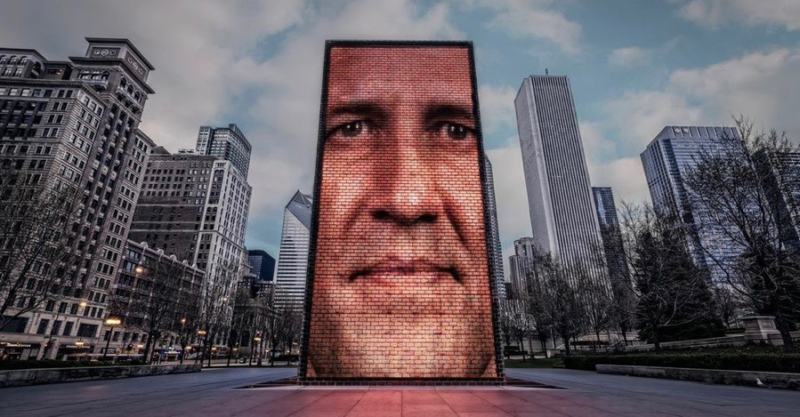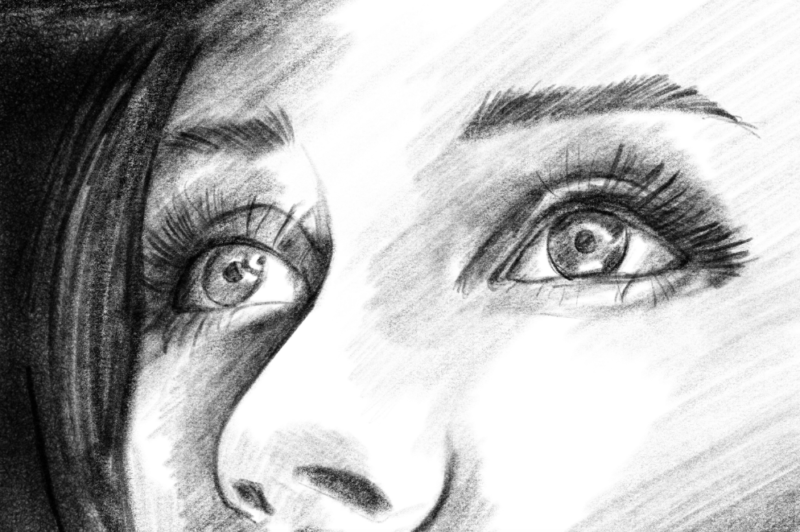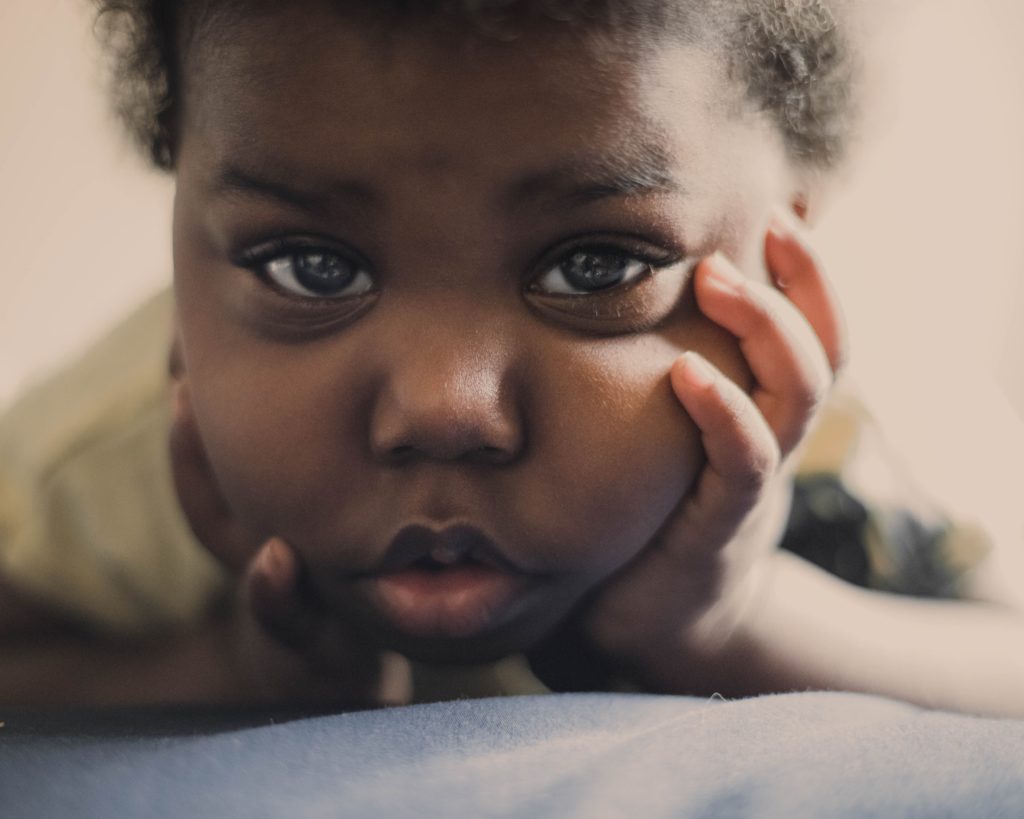Intro: Seeing the Face
Pause and look into the face of a person near you. Or if you prefer, look into the man’s face from the Crown Fountain in Chicago. Try to keep eye contact for ten seconds.

When you see another person’s face and don’t look away quickly, something profound happens. You make a discovery that takes you deep into the heart of reality and what it means to see truthfully, beautifully, and reverently.
Seeing another’s face brings into focus the intersection of intimacy and mystery, presence and hiddenness, access and inviolability, which inheres in all reality. The face is simultaneously a window and wall for our gaze, an invitation and a limit.
Let me try to describe the face’s paradox and how seeing it might help rehab how we see all things.
Intimacy: The Window
When you see the eyes of the other person, you see that someone is looking back at you. Your gaze is being met and returned, and thus you are not only seeing but being seen. You are not alone; a visual dialogue of acknowledgement is taking place. Surplus rather than a flat object meets your eyes. Thus, the eyes silently say:
“I see you. We see each other. We are not alone. We are here together. Welcome. Let’s begin communicating.”
The gaze, then, becomes a physical bridge into perhaps the most wondrous reality in the world – personhood and our ability to behold one another, to be there for one another, to share the world with one another in meaningful ways as we acknowledge one another’s presence and grow in intimacy.
Seeing the other’s eyes is like looking through a window into a new world. As Peter Gabriel sang, “In your eyes, I see the doorway to a thousand churches.”
Mystery: The Wall
But, simultaneously, when we look into the eyes of another person, we also discover a radical limit to our seeing.
Sight cannot see all that we are. Our vision is not a magical device that can insert itself behind the eyes and observe another’s inner thoughts. For example, in the picture above, it is unclear whether the man’s face shows a warm gaze or tense stare, a sense of peace or subtle worry. His face both reveals and conceals who he is and what is inside.
Seeing the other person’s face, then, is an immediate reminder that there is so much more to them than we could ever know, recognize, speculate, or infer. Perhaps your tears are tears of deep joy or deep pain. Perhaps the lines I see around your eyes come from the passion of love or the ache of depression. Perhaps your face doesn’t indicate what you are thinking or feeling at all. The you I see is never fully present, never fully accessible or comprehendible to my seeing.
So when I see clearly, I see that you far exceed my vision. I can see so far and no further. There is always more to you than meets my eye, and paradoxically my sight reminds me of this very fact. Your eyes silently meet mine and say:
“Do not trespass or presume. You can’t capture me or get inside me with your vision. I am more than you know. Stand back and wait patiently.”

Respect: Re-seeing
Sight here is paradoxical, holding together two aspects in tension. It is simultaneously the physical faculty that enables some of our most personal connection and intimacy, as well as the veil that conceals our most personal secrets and mystery. Seeing brings us together and holds us apart. The eyes open to an infinity that can be encountered but not exhausted in one another.
From this perspective, it is fascinating that the word “respect” literally means to “look back” or “see again.” In a profound sense, respect is a re-seeing or double vision that recognizes both aspects of seeing’s paradox. We can encounter one another, but we can never capture one another. We can touch but not grasp.
The respectful person sees that both are true. And thus they behave with initiative and restraint. They draw near while observing boundaries. They strive to grow in intimacy while cherishing mystery. The respectful seer refuses to carelessly look away or violently occupy. They are present, attentive and available, but not presumptuous, invasive, or grasping. Their eyes are strong and tender.
Re-seeing Body and Soul
I have experienced that beholding others’ faces can serve as a vision therapy for how we see in general, as well as how we “see” the invisible God, in our daily lives. The paradox of the face – seeing with limits, encounter without capture – can be observed in most of what we see when we pay attention, and noticing this pattern trains our seeing with an attunement of intimacy and wonder in all things.
Jenna Herskind, a former student at Wheaton College who is now in medical school at Buffalo, eloquently described this way of seeing in a recent email to me that reflected on her studies:
“I’ve come to consider the study of anatomy the ultimate juxtaposition of intimacy and mystery… I see this juxtaposition in my relationship with my teacher [a cadaver] in the lab. I know the man in table 13, in many ways, more thoroughly than any spouse/lover/family member/friend ever has. Somehow, I also know absolutely nothing about who he was. I know how incredibly healthy his heart was because I held it in my hands; but I’ll never know if he preferred long hikes or short sprints or meandering walks. I cleaned and moved and noted every sphincter/muscle of facial expression on his head; yet I’ll never know what kinds of things he smiled at, or what made him angry, or what moved him deeply. I know the man at table 13 more intimately than most everyone who ever knew him, and yet the fibers of love and experience and suffering that made up his life are an utter mystery to me. The study of anatomy has juxtaposed an intimate and intricate knowledge of the human body with the humbling mystery of how much we do not know.”
Jenna went on to unpack how this way of seeing as a medical student in the lab has informed her self-perception as a person:
“I see these patterns of mystery and intimacy in my own life. The teachers’ gifts have caused me to reflect on my own humanity, and I now find myself confronted with the intimacy and mystery of me… I can now describe many of the biological processes happening in my body at any given moment; yet I will never see–will never know–the inside of myself the way I know our teacher upstairs. And the mystery of myself extends far beyond the biological: though I can explain exactly how tears make it from the lacrimal gland to the inferior meatus, I am awed by how deeply I can feel emotion, yet not understand the vast array of factors that cause that emotion. Finitude is a mark of humanity; I am the only one who will ever have the experience of being me, and I will never have the experience of being anyone else. Studying anatomy has revealed that, though I know myself more intimately than anyone ever could, I am and will always be a mystery to myself.”
Jenna concluded this part of her email by expressing the deep awe that seeing the intersection of intimacy and mystery – in another’s skin and in her own – has brought to her life.
Re-seeing the World as God’s Creation
From a Christian perspective, this awe-inspiring intimacy and mystery pervades and saturates all that we see and experience as humans.
For example and most basically, Christians believe that we have never seen anything that God has not made or that has not been made from what God has given – the heavens, the earth, all matter, life, and persons. In all things, there is always a depth-dimension, a hidden aspect “behind the eyes,” to what we see – reality’s “creatureliness” or the investment of creativity and care into all things by our invisible Creator.
The fingerprints of God mark each thing that is, and, rather than smudges, they are lenses that call for our seeing.
In his Confessions, Augustine described the “beams” of his eyes as “corporeal messengers” going out to behold the world – the earth, the sea, creeping things, the breezy air, the sun, moon, and stars. He reported that when he looked at all the phenomena of the world,
“With a loud voice they exclaimed, ‘He made us!’ My questioning was my observing of them; and their beauty was their reply.” (Confessions, X.9)
For Augustine, the world that surrounds us and everything in it has an iconic dimension or beauty that points toward divine creativity and care, God’s own intimacy and mystery in all things.
John Calvin had a similar vision in his Institutes of the Christian Religion. There he called the visible world God’s “apparel” and “insignia,” the “sparks of his glory,” which we can see “whenever and wherever we cast our gaze.” Calvin explained:
You cannot in one glance survey this most vast and beautiful system of the universe, in its wide expanse, without being completely overwhelmed by the boundless force of its brightness. The reason why the author of the Letter to the Hebrews elegantly calls the universe the appearance of things invisible (Heb. 11:3) is that this skillful ordering of the universe is for us a sort of mirror in which we can contemplate God, who is otherwise invisible. Calvin, Institutes, I.5.1
Augustine looks at the world and hears a voice that exclaims, “He made us!” Calvin looks at the world and sees “a sort of mirror” in which we glimpse “the sparks” of God’s glory. Like the human face, the face of the world presents to our vision what can be seen and what is invisible, a visual covenant of intimacy and mystery that calls for enlarged vision attuned with welcome and reverence.
Gerard Manley Hopkins gave words to this rehabilitated seeing in his beautiful poem “Pied Beauty.” (“Pied” means having two or more colors.)
Glory be to God for dappled things –
For skies of couple-colour as a brinded cow;
For rose-moles all in stipple upon trout that swim;
Fresh-firecoal chestnut-falls; finches’ wings;
Landscape plotted and pieced – fold, fallow, and plough;
And áll trádes, their gear and tackle and trim.
All things counter, original, spare, strange;
Whatever is fickle, freckled (who knows how?)
With swift, slow; sweet, sour; adazzle, dim;
He fathers-forth whose beauty is past change:
Praise him.
Skies streaked like a cow, fish dotted with colors, nuts like glowing charcoal, birds’ wings, land with many colors and crops, all forms of work – Hopkins sees the glory of God in all of this and celebrates it with praise.
Rehabbing Sight
Looking into the face of another person is the beginning of a therapy that can awaken and train our eyes in the mystery of all things, from our bodies to our souls, from creation to God himself.
Our eyes see intimacy and mystery, presence and hiddenness, a window to look through and a wall to wait upon. Our vision can see and also see that it cannot see.
And thus we are called to look always and everywhere at all things with welcome and reverence, with that respect that “looks again” and refuses indifference or violence but offers attention, care, and awe.
I ask, what if seeing itself – both the way we see and what we see – could become a spiritual practice for us, an endless visual eucharist or prayerful celebration of the world as the gift and icon of God? What if opening our eyes and beholding what we see is itself an endless form of devotion, which trains us in a practice of God’s presence and blurs the lines of sacred and secular, church and world, heaven and earth, the invisible God and our embodied experience?
With practice, I believe this is possible, and it can deliver us from a part-time spirituality into a sacred way of life, as Jean Vanier described:
It is essential for all of us to find the nourishment we need in daily life itself… Daily life is only nourishing when we have discovered the wisdom of the present moment and the presence of God in small things. It is only nourishing when we have given up fighting reality and accept it, discovering the message and gift of the moment… Each of these can be an occasion for wonder and awe, a moment of the presence of God.
Jean Vanier, Community and Growth
Let the face of your neighbor be an icon that reminds you to see with rehabbed vision this week. The sparks of God’s glory are everywhere to behold.
***
“Christ plays in ten thousand places,
Lovely in limbs, and lovely in eyes not his
To the Father through the features of men’s faces.”
Gerard Manley Hopkins, “As Kingfishers Catch Fire”




